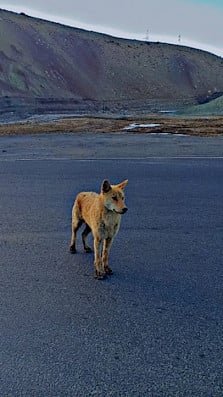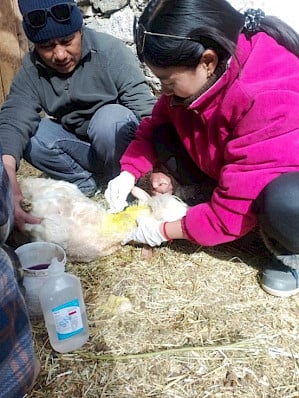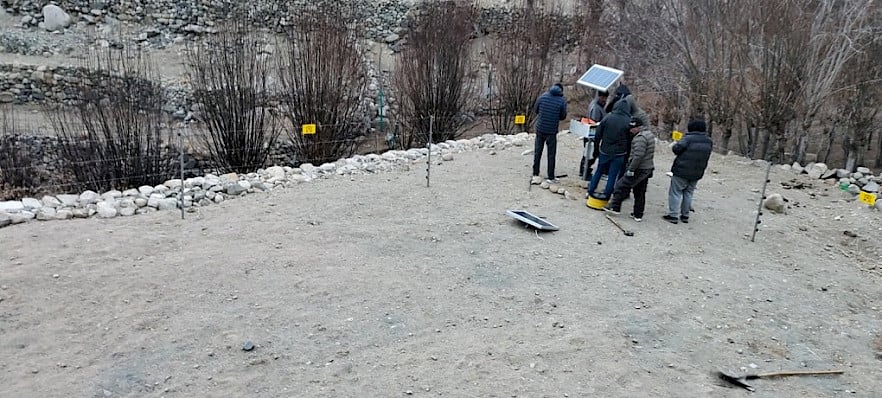
Issue no. 13
July 2025
Beyond the Bite: Ecological Consequences of Stray Dogs in Ladakh
Ladakh, located in the Trans-Himalayan region, is characterized by its high altitude, arid climate and low primary productivity. This unique landscape supports a fragile ecosystem with scarce resources and specialized wildlife, including endangered species such as the snow leopard, Tibetan Argali, Himalayan Marmot and Black-necked Crane. Each species is uniquely adapted to extreme environmental conditions, making the ecosystem highly sensitive to even minor disturbances.
In recent years, the rising population of feral and stray dogs, driven by increased tourism, urban sprawl and unmanaged waste, has emerged as a significant ecological concern. These free-ranging dogs disrupt natural predator-prey dynamics, prey on native wildlife, compete with indigenous carnivores and pose risks of disease transmission. Their growing presence in this already resource-scarce environment threatens to undermine conservation efforts and ecological balance. This issue brief examines the ecological and socio-economic implications of stray dogs in Ladakh, and analyses the systemic drivers and governance gaps behind the crisis.
Status Overview
Stray Dog Population
Ladakh is witnessing a notable increase in its stray dog population. In Leh district alone, estimates suggest there are approximately 9,000 to 10,000 stray dogs, equivalent to nearly 30% of the human population in the region (Suryaa News, 2022). Across the Union Territory, the total population of stray dogs is believed to be around 25,000 (Shrivastava, 2023).
Sterilization and Vaccination Efforts
To address this growing issue, the Department of Animal and Sheep Husbandry has undertaken sterilization and vaccination initiatives under the Animal Birth Control (ABC) programme. Since 2013, about 26,684 dogs have been sterilized (Ladakh Administration, 2023; Voice of Ladakh, 2023a). In recent campaigns, 189 dogs in Khaltse and 128 dogs in Nyoma sub-divisions were sterilized and vaccinated against rabies in June 2023 (Indus Dispatch, 2023).
Dog Bite Incidents
According to the Integrated Disease Surveillance Programme (IDSP), Ladakh reported 2,165 cases in 2022, 2,569 in 2023 and 4,078 in 2024, indicating a worsening public health issue (PIB, 2024). Deadly attacks by stray dogs have also been recorded, often triggering widespread concern over the risks posed by unmanaged populations. In March 2023, a 79-year-old woman was mauled to death by stray dogs in Rantaksha village, Zanskar (The Statesman, 2023). Similar fatal incidents were previously reported in 2014 and 2015, in Spituk and Saspol village, respectively (Daily Excelsior, 2015).
Ecological Impacts of Increasing Stray Dog Populations
Free-ranging dogs are both scavengers and active predators, leading to cascading effects on ecological processes. Their predatory behaviour and competition with native carnivores such as snow leopard, wolf, red fox, etc., disrupt food webs and endanger species. Alarmingly, interbreeding between feral dogs and wild wolves has been observed in parts of Ladakh (Figure 1) and Spiti, raising concerns about genetic dilution, altered predator behaviour and further ecological destabilisation (Hennelly et al., 2015).
Figure 1. A suspected dog-wolf hybrid, locally known
as kheb-shang in Ladakh

Source: Phuntsog Dolma
One critical case is the Black-necked crane—a culturally revered and a globally vulnerable species. Its breeding success in Ladakh has declined from 60% in 1994 to 33% in 2017, with dog predation identified as a major reason for chick mortality (Patil, 2022). Similar concerns have been raised for other key species including the kiang, whose populations are under pressure from dog attacks, over-tourism and habitat disruption (Ghai, 2024).
These dogs not only threaten prey species but also compete with and displace native carnivores such as snow leopards, Eurasian lynx and Pallas’s cat (Ansh, 2024). A study conducted in Changthang Wildlife Sanctuary found exceptionally high densities of free-ranging dogs—up to 310 individuals per 100 sq. km in Hanle and 61 per 100 sq. km in Tso Moriri, far exceeding densities of native carnivores (Patil & Uniyal, 2020; Mahar et al., 2023). Scat analysis (i.e., analysis of faecal matter to study diet profile) reveals that 74.29% of stray dogs’ diet consists of livestock and 13.06% is from wild species, including birds and rodents, as well as threatened species like the Tibetan wild ass or kiang (Mahar et al., 2023).
Ecosystem and Habitat Pressure
Ecologically sensitive areas such as Hemis National Park, Karakoram Wildlife Sanctuary and Changthang Wildlife Sanctuary are among the high-risk zones for stray dog proliferation (Dar et al., 2023). Dogs thrive near roads, settlements and water sources; their spread is influenced by elevation and moisture. This results in conflict between conservation goals and unregulated development. Beyond direct predation, stray dogs contribute to disease transmission, displacement of native fauna and disruption of ecological roles carried out by native predators.
Comparative Insights from Other Mountain Regions
Himalayan regions like Himachal Pradesh and Sikkim reveal similar trends. In Pangi and Lahaul valleys, 12% and 6.7% of respondents reported livestock losses due to feral dogs. Diet analysis indicated predation on cattle, horses, goats, rodents and even wild herbivores like blue sheep and marmot. Food dumping sites were identified as hotspots for infestation. Abandoned guard dogs and those habituated to the wild were identified as key contributors (MoEFCC, 2022). In Spiti, feral dogs caused 68% of livestock deaths—more than wild carnivores (Kumar & Paliwal, 2015). In Sikkim, pastoralist Dokpa communities face regular yak predation from dogs sustained on waste near army camps and tourist hubs (Luxom et al., 2022).
In India, nearly 35 million out of 60 million dogs are estimated to be free-ranging. At least 80 wild species are threatened by dog predation, nearly half of which are listed on the IUCN Red List (Variyar, 2022). Globally, nearly 200 threatened vertebrates are impacted by dogs through predation, competition and hybridization, contributing to 11 extinctions (Doherty et al., 2017). Protected areas are not immune: 48% of feral dog attacks in India occur in or near national parks and reserves. In Rajasthan, dogs are primary killers of Chinkara (Indian Gazelle) and disrupt vulture conservation by chasing birds off carcasses (Patil & Uniyal, 2020).
Socio-economic Dimensions
Socio-Ecological Intersections
The ecological threat is compounded by socio-cultural changes in pastoral communities. As traditional herding systems erode and land-use patterns shift, waste generation and human encroachment increase, providing stray dogs with reliable food sources. In Hanle and Tso Moriri in Eastern Ladakh, pastoralists report serious concerns over livestock predation, with economic and emotional losses. A perception study showed that around 40% of respondents view stray dogs negatively, with greater concern among pastoralists (Mahar et al., 2023).
Impacts on Livestock and Pastoral Economies
In peri-urban Leh, stray dogs account for about 13% of reported livestock deaths—an average loss of Rs.3,984 (USD 48) per household (Pahuja & Sharma, 2021). In Saspol block of Leh district, dog attacks rose from 15 (9 deaths) in 2023–24 to 99 (43 deaths) in 2024–25, contributing to declining small ruminant (sheep and goat) rearing (Chosdol, 2017). Local officials note that these attacks are becoming a leading factor contributing to the decline in small ruminant rearing in the parts of the region (personal communication with line agency personnel).
Figure 2. Sheep injured in a stray dog attack in Saspol village, indicating
growing conflict with livestock

Source: Phuntsog Dolma
Policy Response and Management Strategies
In May 2023, the Ladakh administration launched a five-pronged action plan to address the growing stray dog population. The plan includes: (1) deployment of sterilization teams; (2) ear-tagging of sterilized dogs; (3) establishment of shelters; (4) improved food waste management; and (5) set-up of animal helpline (Rasgotra, 2023). While necessary, these measures face obstacles—especially in areas with unregulated food sources near army, labour and tourist hubs. Their effectiveness is also hindered by weak inter-agency coordination and limited public awareness (Dar et al., 2023).
Notably, the Animal Welfare Board of India’s (AWBI) central funding for the ABC and immunisation scheme dropped from Rs.24.4 lakh in 2018–19 to just Rs.4.03 lakh in 2020–21, with no funds allocated thereafter—placing increased pressure on state agencies and weakening programme capacity (AWBI, 2023–24). Between 2008-2018, the AWBI invested approximately Rs.22.5 crore in dog sterilisation programmes, but the persistent rise in wildlife and livestock losses suggests that sterilisation alone has not been an effective deterrent (Variyar, 2022).
Though community-backed ABC and anti-rabies campaigns, including colour-coded collars, have shown promise (Ladakh Administration, 2024), broader ecological and behavioural issues remain unresolved. For instance, in Saspol, reported livestock depredation more than doubled within a year, even after interventions. The steep rise in incidents, even after continued intervention, highlights key gaps in current strategies, particularly in sustaining public awareness, regulating food waste and ensuring inter-agency coordination.
Effective management requires coupling sterilization with improved food waste management and support for traditional practices like the use of guardian dogs (Mahar et al., 2023). A promising solution was piloted in Liker village in Sham belt of Leh district in December 2024, where solar-powered electric fencing was installed to protect livestock (Figure 3). This non-lethal system has reportedly prevented further dog incursions, offering a scalable, humane model for remote regions.
Figure 3. Solar-powered electric fence on trial-basis to protect livestock

Source: Phuntsog Dolma
To enhance the effectiveness of current strategies, the following policy and management actions are recommended:
- Map ecological hotspots using wildlife monitoring and community reporting to identify areas of high conflict.
- Strengthen food waste management, especially near tourist, labour and military settlements, to reduce key attractants.
- Promote awareness about responsible pet ownership and the ecological risks posed by free-ranging dogs.
- Support traditional herding systems and expand the use of guardian dogs to reduce livestock vulnerability.
- Facilitate inter-sectoral coordination among wildlife, municipal, veterinary, health and rural development departments.
Conclusion
The surge in stray dog populations in Ladakh presents a complex socio-ecological challenge. These animals endanger native wildlife, jeopardize conservation outcomes, increase livestock losses and elevate public health risks. The drivers of this crisis range from unregulated tourism, food waste proliferation and poor pet management to the erosion of traditional land-use practices reflecting broader transitions in Ladakh’s social and ecological landscape.
Addressing these challenges calls for science-based, locally- anchored and multi-sectoral strategies. Solutions must go beyond sterilization campaigns to include ecosystem monitoring, waste regulation and community-led livestock protection. Successful examples from villages like Liker suggest that context-specific, human interventions can be both effective and socially acceptable.
Comparative insights from other mountain regions, such as Spiti and Sikkim, show that feral dog proliferation is a recurring problem across the Himalaya, often rooted in similar systemic gaps—unplanned development, militarized landscapes, weak enforcement and neglect of traditional herding practices. Globally, free-ranging dogs have contributed to the decline of nearly 200 threatened species, underscoring the urgency for decisive action (Doherty et al. 2017).
This is not merely a local nuisance but a larger ecological governance crisis. There is a critical need for coordinated responses that bring together wildlife departments, waste management agencies, local communities, and researchers. National-level attention, cross-regional learning, and embedding of community-based dog control within conservation and development planning are essential.
Ladakh is uniquely positioned to lead in demonstrating ecologically-sound, culturally-informed and scalable solutions. With sustained political will, public awareness, and institutional coordination, Ladakh can move beyond reactive control and become a model for humane and integrated stray dog management in high-altitude regions.
Acknowledgement
The authors thank the Sheep Husbandry Department, Leh, for their generous support and for sharing vital field insights.
REFERENCES
Animal Welfare Board of India (AWBI). 2022-23. Annual Report 2022-2023. Ministry of Fisheries, Animal Husbandry and Dairying, Government of India. https://awbi.gov.in/uploads/regulations/170445670534AR%202022-23%20-%20English_compressed.pdf
Ansh, A. 2024. ‘Stray Dogs and Climate Change Threaten Ladakh’s Snow Leopards’. India Spend Magazine. 11 December. https://www.indiaspend.com/climate-change/stray-dogs-and-climate-change-threaten-ladakhs-snow-leopards-934303
Chosdol, K. 2017. ‘Menace of stray dogs: 75 goats, sheep killed in Shachukul’. Reach Ladakh Bulletin. 14 June. https://www.reachladakh.com/news/social-news/menace-of-stray-dogs-75-goats-sheep-killed-in-shachukul
Dar, S.A., A. Sharief, V. Kumar, et al. 2023. ‘Free-ranging dogs are seriously threatening Himalayan environment: delineating the high-risk areas for curbing free-ranging dog infestation in the Trans-Himalayan region’. Environmental Monitoring and Assessment. 195:1386. 1-16. https://doi.org/10.1007/s10661-023-11972-6
Doherty, Tim S., Chris R. Dickman, Alistair S. Glen, Thomas M. Newsome, Dale G. Nimmo, Euan G. Ritchie, Abi T. Vanak, and Aaron J. Wirsing. 2017. ‘The global impacts of domestic dogs on threatened vertebrates’. Biological Conservation. 210. 56-59. https://doi.org/10.1016/j.biocon.2017.04.007
Ghai, R. 2024. ‘World Donkey Day 2024: Overtourism, feral dogs, conflict with herders & unplanned development threats for Ladakh’s kiang. Down To Earth Magazine. 7 May. https://www.downtoearth.org.in/wildlife-biodiversity/world-donkey-day-2024-overtourism-feral-dogs-conflict-with-herders-unplanned-development-threats-for-ladakh-s-kiang-96022
Hennelly, L., B. Habib & S. Lyngdoh. 2015. ‘Himalayan wolf and feral dog displaying mating behaviour in Spiti Valley, India, and potential conservation threats from sympatric feral dogs’. Canid Biology and Conservation. 18:7. 27-30. http://www.canids.org/CBC/18/mating_of_hima-layan_wolf_and_feral_dog.pdf.
Indus Dispatch. 2023. ‘Over 26684 dogs sterilized till July 10 in Ladakh’. 13 October. https://indusdispatch.in/over-26684-dogs-sterilized-till-july-10-in-ladakh/
Joshi, B.D., L.K. Sharma, M. Thakur, A Kaur, & K. Chandra. 2020. ‘Assessment of population and impacts of feral dogs on wildlife livestock and humans to design a feral dog management strategy in the Lahaul-Pangi landscape of Himachal Pradesh’. Zoological Survey of India, Kolkata, West Bengal.
Kumar, A., & R. Paliwal. 2015. ‘Feral dogs of Spiti Valley, Himachal Pradesh: An emerging threat for wildlife and human life’. Current Science, 108:10, 1799–1800.
Ladakh Administration. 2023. ‘Stray dogs control to be done through Mission Mode Campaign; Action plans discussed to deal with the issue competently’. Administration of Union Territory of Ladakh. 7 February.
Ladakh Administration. 2024. ‘Administrative Secretary of the Animal Husbandry Department, UT Ladakh Ravinder Kumar launches colored-coded collars for neutered and vaccinated dogs in Leh’. Administration of Union Territory of Ladakh. 6 March.
Luxom, N. M., R. Singh, L. Theengh, et al. (2022. ‘Pastoral practices, pressures, and human-wildlife relations in high altitude rangelands of eastern Himalaya: A case study of the Dokpa pastoralists of North Sikkim’. Pastoralism, 12:37, 1-19. https://doi.org/10.1186/s13570-022-00252-6
Mahar, N., S. Bhatia & P. Sharma. (2023. ‘Do We Need to Unfriend a Few Friends? Free-ranging Dogs Affect Wildlife and Pastoralists in the Indian Trans-Himalaya’. Animal Conservation, 27:1, 53-64. https://doi.org/10.1111/acv.12876
Patil, N. (2022. ‘Free-ranging dogs: Official population control programme is failing in Ladakh (and rest of India); Here is why’. Down To Earth, 12 December. https://www.downtoearth.org.in/governance/free-ranging-dogs-official-population-control-programme-is-failing-in-ladakh-and-rest-of-india-here-is-why-86525
Patil, N. & M. Uniyal. (2020. ‘India’s Wildlife Is under Threat from Free‑Roaming Dogs’. Down To Earth, 23 April. https://www.downtoearth.org.in/wildlife-biodiversity/india-s-wildlife-is-under-threat-from-free-roaming-dogs-70648
Pahuja, M. & R. K. Sharma. 2021. ‘Wild Predators, Livestock, and Free Ranging Dogs Patterns of Livestock Mortality and Attitudes of People Toward Predators in an Urbanizing Trans-Himalayan Landscape’. Frontiers in Conservation Science. 2:767650, 1-13. https://doi.org/10.3389/fcosc.2021.767650
Press Information Bureau (PIB). 2024. ‘Rabies and Dog Bite Case Statistics in Ladakh, 2022–2024’. Government of India.
Rasgotra, S. 2023. ‘Ladakh Launches Five-Pronged Action Plan to Manage Stray Dogs’. The Earth News. 27 May. https://earthnews.in/ladakh-formulates-5-pronged-action-plan-to-address-menace-of-stray-dogs/
Shrivastava, S. 2023. ‘Ladakh’s small cats face resource competition, intimidation by free-ranging dogs’. Mongabay - India. 13 November https://india.mongabay.com/2023/11/ladakhs-small-cats-face-resource-competition-intimidation-by-free-ranging-dogs/
Suryaa News. 2022. ‘Stray dog population growing at alarming rate in Leh’. 6 July. https://www.suryaa.com/74309-stray-dog-population-growing-at-alarming-rate-in-leh.html
The Statesman. 2023. ‘Elderly Woman Killed by Stray Dogs in Zanskar’. 25 March. https://www.thestatesman.com/india/79-year-old-woman-mauled-to-death-by-dogs-in-ladakh-1503166215.html
Voice of Ladakh. 2023. ‘Report on Animal Birth Control Program in Ladakh’. 7 February. https://voiceofladakh.com
Variyar, Purva. 2022. ‘Feral Dogs Vs. Wildlife – A Human-made Disaster in the Making’. Wildlife Conservation Trust. 10 November. https://www.wildlifeconservationtrust.org/feral-dogs-vs-wildlife-a-human-made-disaster-in-the-making/
About the Authors : Dr Padma Ladon is a Post-Doctoral Fellow at the Centre of Excellence for Himalayan Studies, Shiv Nadar University, Delhi-NCR. She holds a PhD in Environmental Science from Jawaharlal Nehru University, New Delhi. Specializing in plant ecology, she focuses on the high-altitude landscape ecosystems.
Phuntsog Dolma is presently working as Flock Supervisor at District Sheep Husbandry Department, Leh UT Ladakh. Earlier she worked at Nature Conservation Foundation (NCF) for 3 years. She is the Co-author of the book Plants of Ladakh: A Photographic Guide, which was published in 2021. She has been awarded Sanctuary Nature Foundation’s Mud on Boots Project 2021-22.
Share this on: